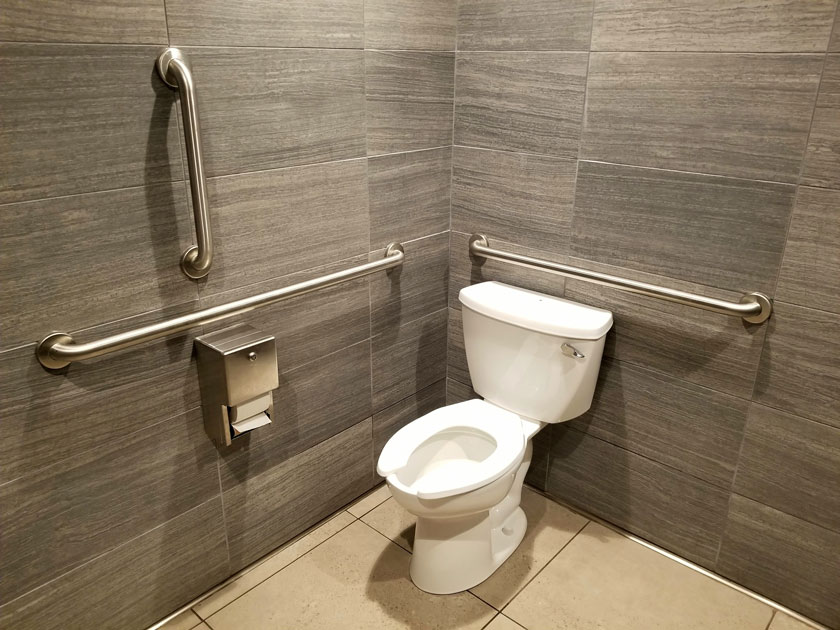Ensuring the safety and accessibility of bathrooms for residents with visual impairments is crucial. Visual impairments can greatly affect one’s ability to navigate new environments, making traditional bathroom designs not only inconvenient but also hazardous. Senior living facilities are increasingly recognizing the importance of modifying these essential spaces and senior living amenities to support the independence and safety of your beloved family members.
Enhanced Lighting Solutions for Increased Visibility
One of the primary concerns for those in their golden years with visual impairments is the ability to see clearly in various parts of the bathroom. To address this, many communities have integrated enhanced lighting solutions that provide ample illumination without being overwhelming.
High-wattage, glare-free lights are installed strategically to brighten up every corner of the bathroom, reducing shadows and increasing contrast, which is vital for those with limited vision. Furthermore, motion-sensor lights ensure that illumination is automatic and immediate, removing the need to locate a switch.
Contrast Techniques to Define Spaces
Navigating a space with a visual impairment can be daunting if the area lacks adequate visual cues. To combat this, senior living facilities use color and contrast to delineate different areas of the bathroom. For instance, a toilet seat might be a significantly different color than the surrounding floor and walls, helping to outline its shape and position.
Similarly, sinks, bathtubs and shower controls often feature bold, contrasting colors that make them easier to identify and use. These visual cues not only enhance safety but also empower residents to use bathroom systems independently and confidently.
Non-Slip Flooring to Prevent Accidents
Slips and falls in the bathroom are a major risk for all older individuals, particularly those who cannot rely fully on their sight. Communities address this hazard by installing non-slip flooring throughout the bathroom area. Materials such as textured tiles or vinyl are chosen for their non-slip properties and are effective even when wet. Additionally, these surfaces are easy to clean, which helps maintain hygiene standards without increasing the risk of slips due to slick surfaces.
Accessible Shower and Bath Design
The design of showers and baths is critical in creating a safe bathing environment. Walk-in showers with no steps or raised thresholds are a common feature, as they eliminate the need to step over a barrier that can be a tripping hazard. Handheld showerheads allow for better control during bathing, which is particularly useful for those with limited vision.
For added safety, these areas are equipped with grab bars strategically placed to assist with balance and mobility and seats are often built into the shower design to provide a place to rest.
Adaptive Fixtures and Smart Technology
Adaptive fixtures and the integration of smart technology are playing pivotal roles in enhancing bathroom safety for visually impaired residents. Faucets with sensors that automatically turn the water on and off can prevent scalding and make operation simpler. Similarly, toilets with automated flushing systems can reduce the need for physical contact, which can sometimes be a challenge to locate and operate.
Voice-activated devices are also becoming more commonplace in bathrooms, allowing residents to control lighting and water temperature and even call for assistance through simple voice commands. These technological enhancements not only increase safety but also foster greater independence.
Emergency Response Features
Recognizing the unique needs of those with visual impairments, emergency response features are critical components of bathroom design in communities. To ensure quick assistance when needed, emergency call buttons are installed within easy reach from the toilet, shower and sink areas. These buttons are typically designed with large, tactile markers so they can be easily located by touch.
In addition, some senior living facilities are incorporating wearable emergency devices that can be activated anywhere in the bathroom, allowing for immediate communication with the care team if a resident feels unwell or experiences a fall. These systems are directly connected to the community’s monitoring team members, ensuring that help is on the way within moments of an alert, thereby increasing the safety and confidence of residents.
Training and Orientation for Residents
To maximize the benefits of these bathroom safety features, retirement communities also provide thorough training and orientation for residents with visual impairments. This includes guided tours where residents can physically experience and learn to navigate their new bathroom setup. Training also covers how to effectively use adaptive fixtures and technology enhancements. By familiarizing residents with their environment, they can feel more comfortable and empowered to perform daily routines with greater autonomy and less reliance on assistance.
Are you or your loved ones looking for a caring and secure environment that caters specifically to those in their golden years with visual impairments? We invite you to explore our community and senior living options. Discover firsthand the comprehensive safety measures and innovative adaptations we have put in place. At our retirement community, we prioritize your safety and independence through thoughtfully designed living spaces. Contact us today to learn more about how we can support you or your beloved family members in enjoying a comfortable and dignified lifestyle.







